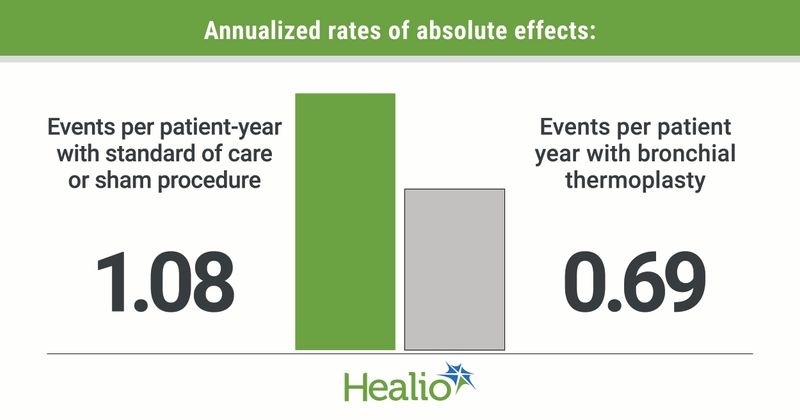Bronchial thermoplasty may reduce exacerbations, improve quality of life in asthma
Key takeaways:
- Bronchial thermoplasty uses thermal energy to reduce bronchial hyperreactivity and airway inflammation.
- The quality of evidence for improvements in exacerbations and quality of life was low.
BOSTON — Bronchial thermoplasty may reduce severe exacerbations and improve control and quality of life in asthma, according to a presentation at the American College of Allergy, Asthma & Immunology Annual Scientific Meeting.
However, the procedure may increase the likelihood for serious adverse events, Leonard B. Bacharier, MD, FACAAI, FAAAAI, said during his presentation.

“Bronchial thermoplasty is an invasive procedure that uses thermal energy in an effort to reduce bronchial hyperreactivity and airway inflammation,” Bacharier, Janie Robinson and John Moore Lee Chair in Pediatrics at Vanderbilt University Medical Center, said.

Bronchial thermoplasty can be considered an adjunct therapy for some adults with severe asthma, including those who are refractory to most pharmacologic approaches, he continued.
“If you read all of the guidelines and all of the position statements out there, they all cite a lack of clear evidence on the effects of bronchial thermoplasty,” he said. “This is a really contentious area in many of our other society and organizational guidelines.”
Bacharier noted that the multiple trials conducted since the previous systematic review prompted the AAAAI/ACAAI Joint Task Force on Practice Parameters, Severe and Difficult to Control Asthma Guideline Development Group to evaluate bronchial thermoplasty in the context of new data and to include all outcomes that matter to patients.
“We had patients and patient advisors helping us figure out which outcomes were important to them,” Bacharier said.
The joint task force conducted a systematic review and meta-analysis that included six randomized controlled trials with 564 participants (median age, 43 years; age range, 41-50 years; 59% women) who had severe asthma. Trials ran for a median length of 52 weeks (range, 4-52 weeks).
But only one of these trials gave all its patients bronchial thermoplasty or a sham procedure, which Bacharier called the most robust form of control.
“All the others compare thermoplasty to standard of care, so they’re not blinded trials,” he said. “There’s only one truly patient blinded trial here, and that really does impact our ability to draw conclusions.”
Overall, the incidence rate ratio for moderate to severe exacerbations was 0.64 (95% CI, 0.53-0.79).
“We found a 36% reduction in the rate ratio for severe exacerbations among patients treated with thermoplasty relative to those not treated with thermoplasty,” Bacharier said.
Annualized absolute effect rates included 0.69 events per patient-year for those who had bronchial thermoplasty and 1.08 events per patient-year for those who had standard of care or a sham procedure.
“So, there’s about 0.4 fewer events per patient-year,” Bacharier said.
Among patients who were at step 5 on the Global Initiative for Asthma guidelines, annualized rates of absolute effects included 0.29 events per patient-year for those on bronchial thermoplasty and 0.46 events per patient-year for those who had standard of care or a sham procedure.
But when the researchers assessed all the factors that contributed to exacerbation outcomes, he continued, they downgraded their confidence in and certainty of their conclusions to low because there was only one study with a true blinded placebo.
And even though that study had a sham control, Bacharier continued, it excluded exacerbations that occurred shortly after the procedure.
“There were exacerbations that these patients experienced that didn’t count toward their outcome because they were considered procedure-related,” Bacharier said. “Well, the patient doesn’t care if the exacerbation was or wasn’t related to the procedure.”
As a result, Bacharier said the researchers believe that the study underestimated the risk for exacerbations among patients with active treatment, probably contributing to the overall difference.
Also, there was a –0.46 weighted mean difference (95% CI, –0.81 to –0.1) in Asthma Control Questionnaire-6 (ACQ-6) scores between patients who had bronchial thermoplasty and those who did not.
Similarly, the risk ratio for improving ACQ-6 scores by a minimally important difference (MID) of 0.5 points was 1.46 (95% CI, 1.1-1.8) for those who had bronchial thermoplasty, with an 18% higher risk difference (95% CI, 4%-31%) for improving by the MID.
Further, there was a 0.62 weighted mean difference (95% CI, 0.37-0.87) in Asthma Quality of Life Questionnaire (AQLQ) scores between those who had bronchial thermoplasty and those who did not.
The risk ratio for improving AQLQ scores by a MID of 0.5 points was 1.56 (95% CI, 1.35-1.74) for those who had bronchial thermoplasty, with a 26% higher risk difference (95% CI, 16% to 34%) for improving by the MID.
But again, Bacharier said, certainty of this evidence was low because patients in five of the six trials knew whether they had received bronchial thermoplasty or not, and patient-reported outcomes are more susceptible to placebo effects.
“Then you have to look at the risk side of this,” Bacharier said.
The risk ratio for serious adverse events was 1.81 (95% CI, 0.84-3.88), with absolute effect rates of 95 per 1,000 patients in the bronchial thermoplasty group and 51 per 1,000 patients among patients who had standard or care or a sham procedure.
“This we felt was pretty well captured,” Bacharier said. “This had moderate certainty of evidence.”
Bacharier encouraged physicians to consider the quality of evidence in discussion treatment options with patients.
“Bronchial thermoplasty may reduce severe exacerbations, but we say that with low level of certainty, and may improve asthma control and asthma-related quality of life, also with low confidence and low certainty, but it likely increases serious adverse events with a level of moderate certainty,” he said. “It’s our job to balance these and convey these to our patients.”

